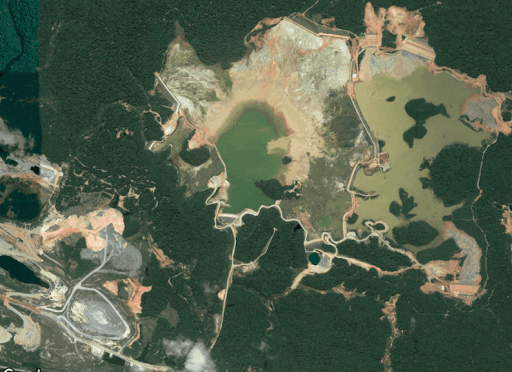THREATS, PRESSURES AND CHALLENGES

Rosebel Mining operated by the Canadian company IAMGOLD. Source: Amazon Conservation Team (ACT)
Permanent Tension
Infrastructure projects, traffic routes and exploitation of mineral wealth make the territory a conflict zone
Currently, 68% of the natural protected areas and indigenous territories in the region overlap with infrastructure projects and investment plans, according to the report Amazonia under pressure, published by RAISG in 2020. The main threats are mining and oil exploration.
Often, these projects were authorized without proper consultation with the affected indigenous populations, disrespecting international treaties and causing health and cultural damage to the peoples of the region, such as oil spills and the resulting pollution of water bodies and fish mortality. The cultural and social damages are not adequately treated by the environmental agencies, making the indigenous populations hostages of the services provided by the concession companies.
Illegal mining is also present in all Amazonian countries. Mining affects food sources, streams, rivers, forests, soils, and is a direct threat to the health of the indigenous peoples. Many studies warn about the high levels of mercury found in the blood of populations affected by mining, which implies long-term consequences, such as neurological. In addition, mining brings food insecurity and violence into indigenous territories.
Dozens of hydroelectric power plants and the opening of more than 100,000 km of roads are planned or in operation in areas overlapping indigenous territories in the Pan-Amazon. Importantly, most deforestation occurs in the vicinity of roads. For example, two important access roads into the Amazon territory of Peru – the Carretera Marginal de la Selva (Ucayali) and the Interoceánica Sur – also act as vectors of deforestation, not to mention the network of forest access roads built without official authorization.
Coca plantations and drug trafficking also affect the region. According to the UN Annual Drug Report 2021, the cocaine trafficking route between South America, the US, and Europe is evolving and has therefore led to the expansion of coca plantations in the Amazon. Cocaine production is concentrated in Colombia, Peru and Bolivia, in areas that coincide with national borders in the Amazon near indigenous territories. The large-scale distribution to the US and Europe is concentrated in Brazil, Colombia and Peru. Drug trafficking implies an increase in violence in indigenous territories.
MAPA INTERATIVO
World Drug Report 2021.United Nations. Office on Drugs and Crimes. Avaiable here
Observe no mapa interativo do Módulo Povos Indígenas, onde se localizam os territórios indígenas na região amazônica e observe as regiões fronteiriças estudadas pelos consultores da OTCA:
